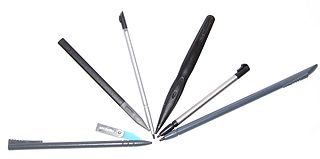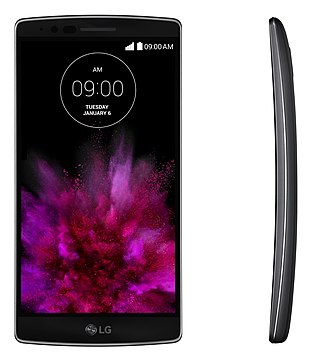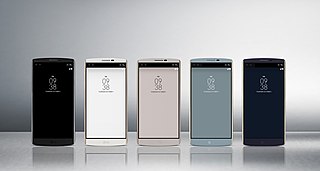
A graphics tablet is a computer input device that enables a user to hand draw or paint images, animations and graphics, with a special pen-like stylus, similar to the way a person draws pictures with a pencil and paper by hand.

In computing, a stylus is a small pen-shaped instrument whose tip position on a computer monitor can be detected. It is used to draw, or make selections by tapping. While devices with touchscreens such as laptops, smartphones, game consoles, and graphics tablets can usually be operated with a fingertip, a stylus can provide more accurate and controllable input.

LG eXpo (GW820) also known as LG GW820 is a projector-enabled mobile phone designed for business users, and manufactured by LG Electronics. It runs Microsoft's Windows Mobile operating system, and was released in December 2009.

The Samsung Galaxy Note is a discontinued line of high-end flagship Android phablets and smartphones developed and marketed by Samsung Electronics. The line was primarily oriented towards pen computing; all Galaxy Note models shipped with a stylus pen, called the S Pen, and incorporate a pressure-sensitive Wacom digitizer. All Galaxy Note models also include software features that are oriented towards the stylus and the devices' large screens, such as note-taking, digital scrapbooking apps, tooltips, and split-screen multitasking. The line served as Samsung's flagship smartphone model, positioned above the Galaxy S series, and was part of the wider Samsung Galaxy series of Android computing devices.

The LG G2 is an Android smartphone developed by LG Electronics. Serving as a successor to 2012's Optimus G and the 2013 Optimus G Pro phablet, the G2 was unveiled at a press event in New York City on 7 August 2013, and first released in September 2013. The G2 is primarily distinguished by software features that LG billed would "learn" from users, a high fidelity sound system designed to produce higher quality audio, a 5.2 in (130 mm) 1080p IPS LCD screen with technology that the company claimed would improve energy efficiency and reduce the size of the bezel around it, along with the unique placement of its power and volume keys—eschewing their typical location on the edge of a smartphone by placing them on the rear below the camera lens.

The LG G series was a line of Android devices produced by LG Electronics. The "G" designation was first introduced in 2012 as a branch of the LG Optimus series for flagship devices, but LG announced in July 2013 that the "Optimus" name would be discontinued for future flagships in favor of maintaining "G" and "Vu" as distinct brands. The first purely G-branded phone, the LG G2, was unveiled in August 2013.

The LG Vu 3 is an Android phablet, released in September 2013 and noted for its 5.2-inch screen size—between that of conventional smartphones, and larger tablets. It is powered by a 2.26 GHz quad-core Krait 400 CPU with Adreno 330 GPU and runs on Android 4.2.2 Jelly Bean. Android 4.4.2 KitKat was also announced for update on 14 March, 2014.

The LG G3 is an Android smartphone developed by LG Electronics as part of the LG G series. First released in South Korea on May 28, 2014, it is a successor to 2013's LG G2. Inheriting design elements from the G2, such as its thin screen bezels and rear-mounted power and volume buttons, the G3 is distinguished primarily by being the first smartphone from a major manufacturer to incorporate a 1440p display, and its inclusion of an infrared hybrid autofocus system for its camera. Its video resolution has been upgraded to 2160p (4K). LG also touted the device's plastic "metallic skin"—designed to give the device a higher quality appearance, and a "simpler" user interface with an integrated intelligent personal assistant system. The battery can be quickly changed by the user, allowing charged spare batteries to be carried.

The OnePlus One is an Android smartphone manufactured by OnePlus. Unveiled in April 2014, it is the first product by OnePlus. The OnePlus One was designed to compare favorably – in performance, quality, and price – to flagship devices by leading smartphone manufacturers. It was also intended to be developer friendly, and has since received a wide variety of ROMs and custom kernels from the community. The OnePlus One shipped to most markets with the Cyanogen OS operating system pre-installed, a commercial variant of CyanogenMod.

Android One is a family of third-party Android smartphones promoted by Google. In comparison to many third-party Android devices, which ship with a manufacturer's customized user interface and bundled apps, these devices run near-stock versions of Android with limited modifications, and a focus on Google services. Devices that run Android One receive OS updates for at least two years after their release, and security patches for at least three years.

LG G Flex 2 is an Android phablet developed and manufactured by LG Electronics. First unveiled by the company on January 5, 2015, it is a successor to the original LG G Flex released in 2013. The design of the G Flex 2 resembles the LG G3, and as with the original, is differentiated primarily by its curved body and flexible display. LG announced several changes from the original G Flex design, including a smaller, higher-resolution display; reduced body curvature; stronger, chemically-treated screen glass; and a new iteration of the original's "self-healing" back cover that can more quickly repair minor abrasions.

The Huawei P8 is a Huawei P Series high-end Android smartphone produced by Huawei. It was originally released in April 2015, alongside two different versions:

The Samsung Galaxy Note 5 is an Android-based smartphone developed, produced and marketed by Samsung Electronics. Unveiled on 13 August 2015, it is the successor to the Galaxy Note 4 and part of the Samsung Galaxy Note series.

The LG V10 is an Android smartphone manufactured by LG Electronics as part of the LG V series. Announced in September 2015 and released in October 2015, the device shares many similarities with the earlier LG G4. Its main feature is a customizable second display above the primary display, which, among other uses, shows notifications and music controls without waking up the primary display. In 2016, its successor, the LG V20 was released.

The Surface Pen is an active stylus and digital pen developed by Microsoft for its series of Surface computing devices. It is designed to showcase the pen computing capabilities of Microsoft's Windows 8/8.1, Windows 10 and Windows 11 operating systems.

The LG G5 is an Android smartphone developed by LG Electronics as part of the LG G series. It was announced during Mobile World Congress as the successor to the 2015 LG G4. The G5 is distinguished from its predecessors by its aluminum chassis and a focus on modularity. Its lower housing, which holds the user-replaceable battery, can be slid from the bottom of the device, and replaced by alternative add-on modules that provide additional functions. Two modules are available: a camera grip, and a high-fidelity audio module with DAC. A lower-spec variation, dubbed the LG G5 SE, is available in some markets.

LG V20 is an Android phone manufactured by LG Electronics, in its LG V series, succeeding the LG V10 released in 2015. Unveiled on September 6, 2016, it was the first phone with the Android Nougat operating system. Like the V10, the V20 has a secondary display panel near the top of the device that can display additional messages and controls, and a quad DAC for audio. The V20 has a user-replaceable battery, unlike its successor, the LG V30, unveiled on 31 August 2017.

The LG L Fino is an Android smartphone/phablet designed and manufactured by LG Electronics. It was released on 10 August 2014.

Huawei Mate 20 is a line of Android phablets produced by Huawei, which collectively succeed the Mate 10 as part of the Huawei Mate series. The flagship models, the Mate 20 and Mate 20 Pro, were unveiled on 20 July 2018 at a press conference in London.

The LG Velvet is an Android phablet manufactured by LG Electronics, announced in May 2020 as a rebrand for the LG G series. The device shares some of its hardware with the flagship V60 ThinQ, with the same display, but a smaller battery and different cameras. On April 5, 2021, LG announced it would be shutting down its mobile phone division and ceasing production of all remaining devices. LG noted the phone would be available until existing inventory ran out.




















